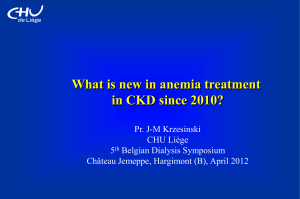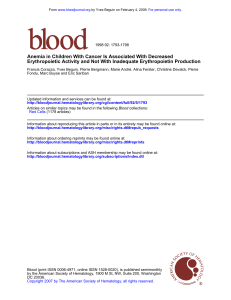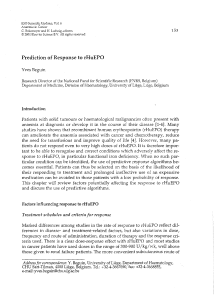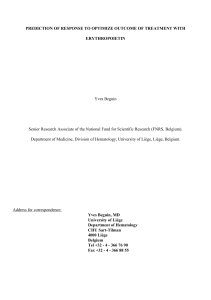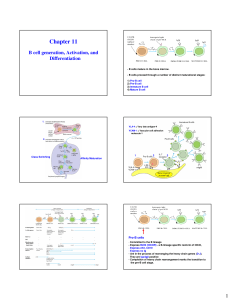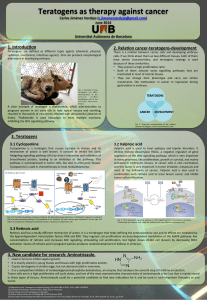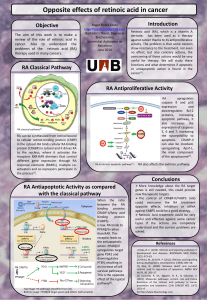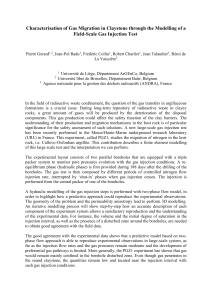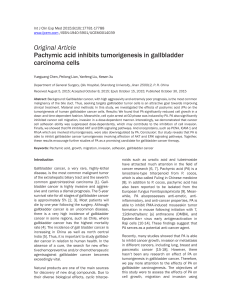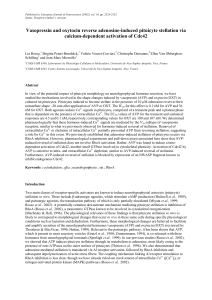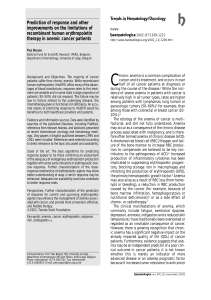Erythropoietin Stimulates Cancer Cell Migration and Activates
publicité
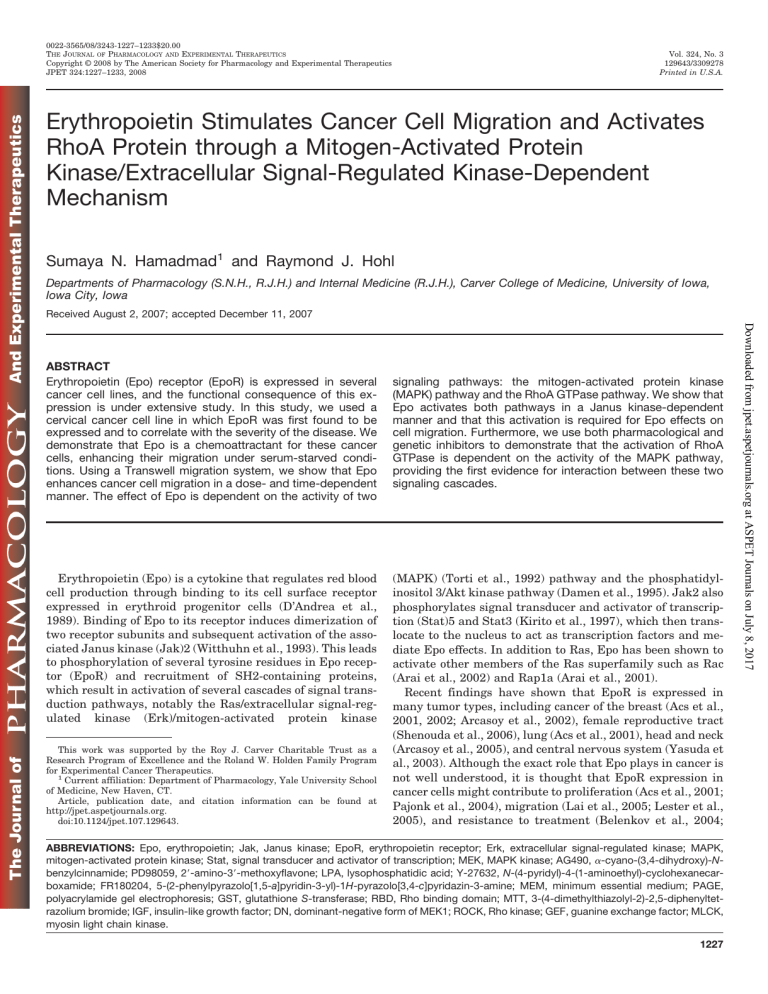
0022-3565/08/3243-1227–1233$20.00 THE JOURNAL OF PHARMACOLOGY AND EXPERIMENTAL THERAPEUTICS Copyright © 2008 by The American Society for Pharmacology and Experimental Therapeutics JPET 324:1227–1233, 2008 Vol. 324, No. 3 129643/3309278 Printed in U.S.A. Erythropoietin Stimulates Cancer Cell Migration and Activates RhoA Protein through a Mitogen-Activated Protein Kinase/Extracellular Signal-Regulated Kinase-Dependent Mechanism Sumaya N. Hamadmad1 and Raymond J. Hohl Departments of Pharmacology (S.N.H., R.J.H.) and Internal Medicine (R.J.H.), Carver College of Medicine, University of Iowa, Iowa City, Iowa Received August 2, 2007; accepted December 11, 2007 Erythropoietin (Epo) is a cytokine that regulates red blood cell production through binding to its cell surface receptor expressed in erythroid progenitor cells (D’Andrea et al., 1989). Binding of Epo to its receptor induces dimerization of two receptor subunits and subsequent activation of the associated Janus kinase (Jak)2 (Witthuhn et al., 1993). This leads to phosphorylation of several tyrosine residues in Epo receptor (EpoR) and recruitment of SH2-containing proteins, which result in activation of several cascades of signal transduction pathways, notably the Ras/extracellular signal-regulated kinase (Erk)/mitogen-activated protein kinase This work was supported by the Roy J. Carver Charitable Trust as a Research Program of Excellence and the Roland W. Holden Family Program for Experimental Cancer Therapeutics. 1 Current affiliation: Department of Pharmacology, Yale University School of Medicine, New Haven, CT. Article, publication date, and citation information can be found at http://jpet.aspetjournals.org. doi:10.1124/jpet.107.129643. signaling pathways: the mitogen-activated protein kinase (MAPK) pathway and the RhoA GTPase pathway. We show that Epo activates both pathways in a Janus kinase-dependent manner and that this activation is required for Epo effects on cell migration. Furthermore, we use both pharmacological and genetic inhibitors to demonstrate that the activation of RhoA GTPase is dependent on the activity of the MAPK pathway, providing the first evidence for interaction between these two signaling cascades. (MAPK) (Torti et al., 1992) pathway and the phosphatidylinositol 3/Akt kinase pathway (Damen et al., 1995). Jak2 also phosphorylates signal transducer and activator of transcription (Stat)5 and Stat3 (Kirito et al., 1997), which then translocate to the nucleus to act as transcription factors and mediate Epo effects. In addition to Ras, Epo has been shown to activate other members of the Ras superfamily such as Rac (Arai et al., 2002) and Rap1a (Arai et al., 2001). Recent findings have shown that EpoR is expressed in many tumor types, including cancer of the breast (Acs et al., 2001, 2002; Arcasoy et al., 2002), female reproductive tract (Shenouda et al., 2006), lung (Acs et al., 2001), head and neck (Arcasoy et al., 2005), and central nervous system (Yasuda et al., 2003). Although the exact role that Epo plays in cancer is not well understood, it is thought that EpoR expression in cancer cells might contribute to proliferation (Acs et al., 2001; Pajonk et al., 2004), migration (Lai et al., 2005; Lester et al., 2005), and resistance to treatment (Belenkov et al., 2004; ABBREVIATIONS: Epo, erythropoietin; Jak, Janus kinase; EpoR, erythropoietin receptor; Erk, extracellular signal-regulated kinase; MAPK, mitogen-activated protein kinase; Stat, signal transducer and activator of transcription; MEK, MAPK kinase; AG490, ␣-cyano-(3,4-dihydroxy)-Nbenzylcinnamide; PD98059, 2⬘-amino-3⬘-methoxyflavone; LPA, lysophosphatidic acid; Y-27632, N-(4-pyridyl)-4-(1-aminoethyl)-cyclohexanecarboxamide; FR180204, 5-(2-phenylpyrazolo[1,5-a]pyridin-3-yl)-1H-pyrazolo[3,4-c]pyridazin-3-amine; MEM, minimum essential medium; PAGE, polyacrylamide gel electrophoresis; GST, glutathione S-transferase; RBD, Rho binding domain; MTT, 3-(4-dimethylthiazolyl-2)-2,5-diphenyltetrazolium bromide; IGF, insulin-like growth factor; DN, dominant-negative form of MEK1; ROCK, Rho kinase; GEF, guanine exchange factor; MLCK, myosin light chain kinase. 1227 Downloaded from jpet.aspetjournals.org at ASPET Journals on July 8, 2017 ABSTRACT Erythropoietin (Epo) receptor (EpoR) is expressed in several cancer cell lines, and the functional consequence of this expression is under extensive study. In this study, we used a cervical cancer cell line in which EpoR was first found to be expressed and to correlate with the severity of the disease. We demonstrate that Epo is a chemoattractant for these cancer cells, enhancing their migration under serum-starved conditions. Using a Transwell migration system, we show that Epo enhances cancer cell migration in a dose- and time-dependent manner. The effect of Epo is dependent on the activity of two 1228 Hamadmad and Hohl Materials and Methods Antibodies and Reagents. RhoA, Erk, and phospho-Erk antibodies were obtained from Santa Cruz Biotechnology, Inc. (Santa Cruz, CA). The Jak inhibitor, AG490 (tyrphostin), the MEK inhibitor, PD98059, and lysophosphatidic acid (LPA) were purchased from Sigma-Aldrich (St. Louis, MO). The RhoA kinase inhibitor, Y-27632, and the Erk inhibitor, FR180204, were both obtained from EMD Chemicals (San Diego, CA). Cell Line and Culture. HeLa cells were obtained from American Type Culture Collection (Manassas, VA). Cells were cultured in minimum essential medium (MEM) supplemented with 10% fetal bovine serum, 100 mM sodium pyruvate, 0.1 mM MEM nonessential amino acids, 100 units/ml penicillin, and 100 g/ml streptomycin. Each culture was maintained at 37°C, 5% CO2 and saturating humidity. Cell Transfection. The expression constructs encoding dominant-negative MEK1 (K97R) was kindly provided by Stefan Strack (University of Iowa, Iowa City, IA). One day before transfection, cells were plated in 10-cm culture dishes so that they would reach approximately 90% confluency the next day. Lipofectamine and Plus Reagent (both obtained from Invitrogen, Carlsbad, CA) were used to transiently transfect the plasmids in Opti-MEM I Reduced Serum Medium without serum. Cells were incubated at 37°C for 5 h before the medium was changed to MEM with 10% serum. Cells were assayed 24 to 48 h after transfection. Cell Lysing and Immunoblotting. Cells were lysed in radioimmunoprecipitation assay lysing buffer [1% sodium deoxycholate, 1% Triton X-100, 0.1% SDS, 1 mM phenylmethylsulfonyl fluoride, 50 mM Tris, 150 mM NaCl, and protease inhibitor cocktail (SigmaAldrich)]. The clarified cell lysates were resolved by 12% SDS-polyacrylamide gel electrophoresis (PAGE) and subsequently Western blotted with the indicated antibodies as described previously (Hamadmad et al., 2006). Cell Migration Studies. HeLa cell migration was studied as described previously (Lester et al., 2005) using 6.5-mm Transwell chambers with 8-m pores (Corning Costar, Corning, NY). The bottom surface of each membrane was coated with 20% fetal bovine serum for 2 h. Approximately 104 cells were seeded in the upper chambers in 100 l of serum-free medium. Lower chambers contained 600 l of serum-free medium, 10% serum, or the indicated concentration of Epo in serum-free medium. When treatments were added, they were added to both chambers. After the cells were allowed to migrate, the medium in the upper chamber was sucked out and cells on the upper side were removed with a cotton swab. Cells on the lower side of the membrane were fixed and stained by Diff-Quik Staining solution (Dade-Behring, Deerfield, IL). Membranes were then cut from each Transwell chamber and transferred to microscope slides. Cells that migrated through the membrane to the lower surface were counted by light microscopy. Rho Activation Assay. RhoA activation was studied using the Rho activation kit (catalog number EKS-465; Assay Designs, Ann Arbor, MI) according to manufacturer’s recommendations. After lysing of the cells, protein concentration was measured, and approximately 700 g of protein was added to each reaction. The glutathione S-transferase (GST)-rhotekin-Rho binding domain (RBD) fusion protein was then used to bind active Rho, and the complex was pulled down with immobilized glutathione column. Pulled-down Rho was then detected by Western blot analysis using a specific RhoA antibody. Results Epo Stimulates HeLa Cell Migration. Previous studies have shown that Epo stimulates invasion of squamous cell carcinoma cells (Lai et al., 2005) as well as migration of breast cancer cells (Lester et al., 2005). To study the effect of Epo on HeLa cell migration, the Transwell migration assay was used. This assay measures the migration of cells across a porous membrane in response to potential stimuli and is a reliable and widely used method for quantifying cell migration. Cells were added to the upper chamber and allowed to migrate for different periods of time. Epo was tested for its ability to promote cell migration when added to the lower chamber in serum-free medium. As shown in Fig. 1A, an increasing concentration of Epo from 5 to 20 U/ml stimulated HeLa cell migration in a dose-dependent manner. A 30 U/ml concentration did not have any added effect over the 20 U/ml concentration, which suggests that the latter value corresponds to the concentration that leads to the maximal effect of Epo. As shown in Fig. 1B, Epo induction of migration was also time-dependent because it increased the number of migrating cells with time within the time period that was tested (4 –24 h). The effect of Epo was comparable with that of serum. To rule out an effect of Epo on cell viability and/or proliferation, we assessed cell proliferation under the conditions used in the migration studies using 3-(4-dimethylthiazolyl-2)-2,5-diphenyltetrazolium bromide (MTT) assay. We found that the different concentrations of Epo did not affect cell proliferation within the time period (up to 24 h) that were investigated (data not shown). Epo induction of migration was dependent on the activity of Jak, because inhibition of this kinase by the selective inhibitor, AG490, abolished Epo effects without affecting that of serum-induced migration (Fig. 1C). We used 30 M AG490, which is approximately the IC50 of the inhibitor Downloaded from jpet.aspetjournals.org at ASPET Journals on July 8, 2017 Pajonk et al., 2004). Some studies suggested that the Erk/ MAPK pathway plays a crucial role in these processes (Lester et al., 2005); others have pointed to the phosphatidylinositol 3-kinase pathway as a major player (Hardee et al., 2006). Still, little is known about the role of EpoR signaling in tumor cells. Recent studies showed that Epo enhances cancer cell migration both in squamous cell carcinoma (Mohyeldin et al., 2005) and breast cancer cells (Lester et al., 2005). Activation of the Jak2, a step indispensable to all Epo effects, was implicated in both systems. The MAPK/Erk pathway was also shown to be required for the stimulation of migration seen in the breast cancer cell line. Activation of the MAPK/ Erk pathway is critical for stimulation of migration by several agents that support this process (Hinton et al., 1998; Jo et al., 2002; Brahmbhatt and Klemke, 2003). In addition, members of the Rho family, namely RhoA, are known to play an important role in the process of cell migration through their effects on the remodeling of the actin cytoskeleton (Takaishi et al., 1994; Faried et al., 2006). In this study, we sought to understand the molecular mechanism(s) behind the effect of Epo on cancer cell migration. We used HeLa cells, a cervical cancer cell line where EpoR was first found to be expressed and where this expression correlates with the severity of the disease (Shenouda et al., 2006). We show that Epo acts as a chemoattractant that induces chemotaxis of cancer cells. We also demonstrate that this effect is dependent on activation of two signaling pathways by Epo: the MAPK/Erk and RhoA/RhoA kinase pathways. Using chemical inhibitors and dominant-negative forms of MAPK kinase (MEK), we show that activation of the latter pathway is dependent on activation of the first. Epo Activates RhoA in Cancer Migrating Cells A 2000 1800 1600 1400 1200 1000 800 600 400 200 0 0 5 10 20 30 Serum Epo (U/ml) 500 400 No Epo 300 + Epo 200 100 0 4 8 12 24 Migration Time (hr) Percentage of Migrating Cells C 450 400 350 300 Control + AG 490 250 200 150 100 50 0 - Epo Serum Fig. 1. Epo produces a dose- and time-dependent induction of HeLa cell migration. A, HeLa cells were added to the upper chamber of the Transwell system as described under Materials and Methods. Epo was added to the lower chamber at the concentrations indicated, and the cells were allowed to migrate for 12 h. Ten percent serum was used as a control. Cells that migrated to the other side of the membrane were counted and are shown (mean ⫾ S.D., n ⫽ 4). B, cells were allowed to migrate for the indicated periods of time in the presence of 20 U/ml Epo in the lower chamber. Cell migration is expressed as a percentage of that observed in cells without Epo at the 4-h time point (mean ⫾ S.D., n ⫽ 4). The actual number of cells migrating in the absence of Epo at the 4-h time point is 750 ⫾ 30. C, HeLa cells were treated or not (control) with 30 M AG490 and allowed to migrate for 12 h in the absence or presence of 20 U/ml Epo or 10% serum. AG490 was present in both chambers of the Transwell system during the migration period. Cell migration is expressed as a percentage of that observed in control (no AG490 added) cells without Epo (mean ⫾ S.D., n ⫽ 4). The actual number of control cells migrating in the absence of Epo is 860 ⫾ 53. (Eriksen et al., 2001). AG490 did not affect cell proliferation under the conditions tested as assessed by the MTT assay (data not shown). Epo Activates Erk Phosphorylation in HeLa Cells. It is well established that Epo can activate the Erk/MAPK pathway, and several studies have implicated this pathway in induction of cell migration in several cell types (Nguyen et al., 1998; Lester et al., 2005; Monami et al., 2006). Therefore, we wanted to test the effect of Epo on Erk phosphorylation in HeLa cells. Stimulation of cells with Epo led to phosphorylation of Erk within 2 min (Fig. 2A). This effect was maxi- mum after 10 min of Epo stimulation and seemed to decrease after 60 min, although it stayed well above basal level even after 90 min of stimulation. Total protein level of Erk was not affected by Epo stimulation. As expected, serum also activated Erk phosphorylation. As shown in Fig. 2B, the activation of Erk was occurring in a Jak-dependent manner as the Jak inhibitor, AG490, inhibited Erk phosphorylation in response to Epo. To show specificity of AG490 toward Jak, we tested Erk activation by insulin-like growth factor (IGF)-1, which does not require Jak activity for Erk induction. As shown in Fig. 2B, AG490 treatment did not affect Erk activation by IGF-1, which confirms that AG490 is inhibiting Erk in Epo-treated cells by indirectly inhibiting the upstream Jak. Epo Stimulation of Cell Migration Is MAPK-Dependent. To assess the role of Erk phosphorylation in Epo stimulation of cell migration, we treated the cells with the PD98059 (Alessi et al., 1995), a selective inhibitor of MEK, the kinase that activates both Erk-1 and Erk-2 by phosphorylation, and tested its effect on cell migration in both the presence or absence of Epo. The inhibitor was added to both the upper and lower chambers of the Transwell system, and cell migration was studied as described above. Inhibition of the MAPK pathway completely abolished the effect of Epo on stimulation of cell migration (Fig. 3A). Inhibition of the MAPK pathway by PD98059 was confirmed by its ability to inhibit Epo-induced phosphorylation of Erk protein (Fig. 6). To further confirm our findings, we transfected the cells with a dominant-negative form of MEK1 (DN-MEK) and tested its effect on cell migration in response to Epo. The results of these experiments are shown in Fig. 3B. These results were in agreement with the effect of PD98059, although there was slightly less effect with the DN-MEK, which is contributed to lower transfection efficiency that was achieved with transient transfection. This confirmed that the MAPK pathway plays an essential role in Epo induction of cell migration. As expected, DN-MEK1 inhibited Erk phosphorylation by Epo treatment (Fig. 6). Epo Activates RhoA Protein in HeLa Cells. To further understand the mechanism behind Epo’s activation of HeLa cell migration, we decided to test the effects of Epo on proteins implicated in the process of cell migration, notably members of the Rho family of small GTPases. It was previously shown that Epo induced activation of several small GTPases, including Ras (Torti et al., 1992), Rap1 (Arai et al., 2001), and Rac (Arai et al., 2002). In this study, we decided to examine the effect of Epo on RhoA, which plays an important role in the process of cytoskeletal organization required for cell migration (Takaishi et al., 1994). Cells were stimulated with 20 U/ml Epo for several time points before lysing. Pulldown experiments were carried out with GST-rhotekin binding domain fusion protein that binds to the GTP-bound form of Rho that represents the active form of the small GTPase. Then, the bound fraction was eluted and analyzed by Western blotting with Rho-specific antibodies. Results of these experiments are shown in Fig. 4A, which illustrates that Epo stimulation led to activation of RhoA protein in HeLa cells within 10 min. This activation was transient because it disappeared within 60 min of Epo stimulation. The total protein level of RhoA was not affected by Epo stimulation during the tested time period. The activation Downloaded from jpet.aspetjournals.org at ASPET Journals on July 8, 2017 Percen tag e o f Mig ratin g C ells B 600 1229 1230 Hamadmad and Hohl A Epo (min) 2 - 10 30 60 90 Serum pErk Erk 600 500 pErk 400 Total Erk 300 200 100 0 Control 2 10 30 60 90 Fig. 2. Epo induces phosphorylation of Erk in HeLa cells. A, HeLa cells were starved of serum for 4 h and then stimulated with 20 U/ml Epo for the indicated periods of time or with 10% serum for 10 min. Cell lysates were subjected to SDS-PAGE and immunoblot analysis to detect phosphorylated and total Erk. Densitometric analysis is shown for this experiment, which is representative of at least three separate experiments. The 0 time point (no Epo stimulation) was used as the control to which the other points were compared. B, cells were treated with 30 M AG490 for 12 h before stimulation with 20 U/ml Epo for 10 min (left) or IGF-1 for 5 min (right). Cell lysates were then subjected to SDS-PAGE and immunoblot analysis to detect phosphorylated and total Erk. Time of Epo Stimulation (min) B Control Epo - AG490 AG490 + IGF + - + pErk Erk of RhoA was occurring in a Jak-dependent manner as the Jak inhibitor AG490 inhibited the activation of RhoA in response to Epo (Fig. 4B). We used LPA, which is a known activator of RhoA protein, as a positive control for RhoA activation (Fig. 4A). We also showed that AG490 treatment did not affect RhoA activation by LPA, which further confirms the selectivity of AG490 toward Jak (Fig. 4B). We next sought to determine whether the RhoA pathway plays a role in Epo induction of migration. To this end, we treated the cells with the Rho kinase (ROCK) inhibitor, Y-27632, and studied its effect on Epo-induced cell migration. Inhibition of ROCK resulted in complete abrogation of the effect of Epo on migration (Fig. 5), which suggests that the effects of Epo are dependent on activation of the Rho/ROCK signaling pathway. Epo Stimulation of RhoA Activation Is Dependent on MEK Pathway. Because Epo activates both Erk and RhoA pathways and both are involved in inducing cell migration, we probed the relationship between these two pathways in mediating Epo induction of migration. To this end, cells were treated with the MAPK pathway inhibitor, PD98059. After incubation for 12 h, Epo stimulation of RhoA was tested as described previously. It is interesting to note that inhibition of MEK activation by PD98059 inhibited Epo-induced activation of RhoA (Fig. 6). To further confirm this finding, we transfected the cells with the dominant-negative form of MEK1 and tested RhoA activation in response to Epo. In agreement with the MEK inhibitor findings, the dominant-negative MEK1 also inhibited RhoA activation in response to Epo (Fig. 6). The effect on RhoA activation can not be attributed to changes in RhoA protein levels because the total levels of RhoA stayed constant during the time of experiment. To show that RhoA is downstream of Erk, the selective Erk inhibitor, FR180204, was tested. The Erk inhibitor abolished RhoA activation without affecting Erk phosphorylation (Fig. 6). Together, these results suggest that RhoA is acting downstream of the MAPK pathway to activate cell migration. Downloaded from jpet.aspetjournals.org at ASPET Journals on July 8, 2017 Percentage of Control 700 Epo Activates RhoA in Cancer Percentage of Migrating Cells A 450 400 350 300 250 Control 200 + PD98059 150 100 50 0 - Epo Serum 400 350 300 250 Control 200 DN MEK1 150 100 50 0 - Epo Serum Fig. 3. Epo activation of cell migration is MAPK-dependent. A, HeLa cells were added to the upper chamber of the Transwell system as described under Materials and Methods. A total of 20 U/ml Epo or 10% serum was added to the lower chamber, and cells were allowed to migrate for 12 h. When PD98059 was used, it was added to both chambers of the Transwell system at a 30 M concentration. Cells that migrated to the other side of the membrane were counted, and cell migration was expressed as a percentage of that observed in control (no inhibitor added) cells without Epo (mean ⫾ S.D., n ⫽ 4). The actual number of control cells migrating in the absence of Epo is 820 ⫾ 40. B, HeLa cells were transfected with dominant-negative MEK1 as described under Materials and Methods. Migration was studied as described in A. The actual number of control cells migrating in the absence of Epo is 690 ⫾ 45. Discussion Erythropoietin receptor has been shown to be expressed in many cancer cells, and the functional consequences of this expression have been extensively studied recently. One of the very first cancers where EpoR expression was demonstrated is cancer of the female reproductive tract, most notably cervical cancer (Acs et al., 2001, 2003). EpoR was found both in cervical cancer cell lines and in specimens from patients with cervical cancer (Acs et al., 2003; Shenouda et al., 2006). The level of EpoR expression was shown to correlate with the severity of the cancer and the metastatic potential of the disease; however, the functional consequence of this expression was not elaborated. Moreover, these cells were found to express Epo mRNA and protein, although no studies have definitely proven their ability to secrete Epo in the surrounding media. More recently, several studies have suggested a role for Epo in enhancing cancer cell migration and invasion induced by serum. These effects were demonstrated in breast cancer cell lines (Lester et al., 2005) and squamous cell carcinoma of the head and neck (Lai et al., 2005). Thus, we hypothesized that Epo induces migration of cervical cancer cells and decided to investigate the pathway(s) that mediates this effect. Our findings demonstrate that Epo induces migration of HeLa cervical cancer cells in serum-free medium by acting as a chemoattractant for these cells. We also show that this effect is dependent on the MAPK and the RhoA pathways that are both activated by Epo stimulation. Furthermore, the activation of RhoA is shown to be dependent on the MAPK pathway, and this was confirmed using pharmacological and genetic inhibitors. Epo activation of downstream signaling pathways is dependent on the activity of the Epo receptor-associated kinase, Jak. This requirement for Jak activity is a hallmark for Epo acting through its receptor. We showed that the effects of Epo on HeLa cell migration and Erk and Rho activation are dependent on Jak activity using the Jak-selective inhibitor AG490. The activation of Erk by Epo is a well characterized process that starts with recruitment of Son of sevenless, the guanine exchange factor (GEF) for Ras, to the phosphorylated tyrosine sites on EpoR that are generated by the activity of Jak. Activated Ras then triggers the signal transduction cascade known as the Raf/MEK/MAPK that culminates in Erk activation (Hamadmad and Hohl, 2007). However, this is the first study to show that Epo activates RhoA, and the exact mechanism for this activation has yet to be elucidated. It is possible that a mechanism similar to the one that leads to Ras activation exists for RhoA in these cells. Several agents that induce migration of cancer cells were found to activate the MAPK pathway. For example, urokinase-type plasminogen activator (Nguyen et al., 1998), epidermal growth factor, platelet-derived growth factor (Graf et A Epo (min) 2 - 10 30 60 LPA 90 GTP-Rho Total Rho B Epo Control - AG490 AG490 + + LPA GTP-Rho + Total Rho pErk Erk Fig. 4. Epo activates RhoA in a Jak-dependent manner. A, HeLa cells were starved for 4 h of serum and then stimulated with 20 U/ml Epo for the indicated periods of time or with 30 M LPA for 5 min. Cell lysates were subjected to pull-down analysis with the GST-rhotekin-RBD fusion protein and then to Western blot analysis with RhoA antibody. Total cell lysates were also Western blotted to determine total RhoA. B, cells were treated with 30 M AG490 for 12 h before stimulation with 20 U/ml Epo for 10 min (left) or 30 M LPA for 5 min (right). Cell lysates were then subjected to pull-down analysis with the GST-rhotekin-RBD fusion protein and then to Western blot analysis with RhoA antibody. Total cell lysates were also Western blotted to determine total RhoA protein level. Downloaded from jpet.aspetjournals.org at ASPET Journals on July 8, 2017 Percentage of Migrating Cells B 450 1231 1232 Hamadmad and Hohl 500 450 Percentage of Migrating Cells 400 350 300 Control 250 + Y27632 200 150 100 50 0 - Epo Serum al., 1997), and proepithelin (Monami et al., 2006) were all found to induce cell migration through activation of the MAPK pathway. The exact mechanism through which MAPK affects migration is not very well defined; however, most studies suggest that Erk acts through activation of the myosin light chain kinase (MLCK), which induces serine phosphorylation of the myosin regulatory light chain and thereby promotes contractility of the actomyosin cytoskeleton (Nguyen et al., 1999). This effect is thought to facilitate retraction of the cell tail. In addition to MLCK, Erk is thought to target other cytoskeletal-associated components, such as caldesmon, microtubules, and Scar/WAVE, which are likely to be involved in the process of migration (Westphal et al., 2000). In this study, we demonstrate that, through activation of the RhoA protein, another mechanism can contribute to the MAPK pathway role in mediating cancer cell migration. Although the exact mechanism for this activation is still not well elucidated, we predict that the kinase activity of Erk Control Epo - + Vector Control PD98059 FR1802 + + - + DN MEK1 + GTP-Rho Total Rho pErk Erk Fig. 6. Activation of RhoA is MAPK-dependent. HeLa cells were treated with 30 M PD98059 or 30 M FR180204 for 12 h (lanes 3 and 4; left) or transfected with control vector or dominant-negative MEK1 (right), as described under Materials and Methods, before stimulation with 20 U/ml Epo for 10 min. Cell lysates were either subjected to pull-down analysis with the GST-rhotekin-RBD fusion protein and then to Western blot analysis with RhoA antibody for active RhoA or directly subjected to Western blot with the indicated antibodies to determine total RhoA, phosphorylated Erk, and total Erk. plays a role in this process. Erk is known to have more than 50 substrates (Kolch, 2000). It is possible that one of the substrates that Erk phosphorylates plays a role in RhoA activation. For example, many GEFs that activate small Gproteins like RhoA are regulated by phosphorylation (Tybulewicz, 2005). Phosphorylation is known to activate Vav, a GEF for RhoA, leading to RhoA activation (Tybulewicz, 2005). Alternatively, GTPase activator proteins, which enhance the intrinsic GTPase activity of the small G-proteins, thus inactivating them, are known to be governed by phosphorylation. Phosphorylation has been shown to inhibit GTPase activator protein function in some instances, leading to enhanced activity of the G-protein (Bernards and Settleman, 2005). In addition, the function of RhoA itself has been shown to be regulated by phosphorylation at several tyrosine and serine sites (Loirand et al., 2006). One or more of the aforementioned proteins could be a member in the growing list of Erk substrates. It is well established that RhoA and other members of the Rho family function primarily in processes that require remodeling of the actin cytoskeleton. In stationary cells, RhoA promotes the formation of actin stress fibers and clustering of proteins in focal adhesions (Kaibuchi et al., 1999). However, recent studies have implicated this protein in the process of cancer cell migration and invasion (Takaishi et al., 1994; Faried et al., 2006). Several hypotheses were suggested to explain this role; however, the exact mechanism is not completely understood. It is believed that the Rho kinase, by inactivating myosin light chain phosphatase, complements the function of MLCK in promoting myosin regulatory light chain phosphorylation and actomyosin contractility (Amano et al., 1996). Our finding that RhoA activation is dependent on Erk pathway activation demonstrates how the process of myosin light chain phosphorylation is orchestrated to generate the coordinated movement of the cell during the process of migration. This is further revealed by the timing of activation of the two pathways; whereas Erk phosphorylation was induced more promptly and sustained for longer time (Fig. 2A), RhoA signaling was activated later and only transiently (Fig. 4). Rho kinase also activates a downstream Downloaded from jpet.aspetjournals.org at ASPET Journals on July 8, 2017 Fig. 5. Epo activation of migration requires ROCK activity. HeLa cells were added to the upper chamber of the Transwell system as described under Materials and Methods. A total of 20 U/ml Epo or 10% serum was added to the lower chamber, and cells were allowed to migrate for 12 h. When Y-27632 was used, it was added to both chambers of the Transwell system at a 30 M concentration. Cells that migrated to the other side of the membrane were counted, and cell migration was expressed as a percentage of that observed in control (no inhibitor added) cells without Epo (mean ⫾ S.D., n ⫽ 4). The actual number of control cells migrating in the absence of Epo is 770 ⫾ 55. Epo Activates RhoA in Cancer References Acs G, Acs P, Beckwith SM, Pitts RL, Clements E, Wong K, and Verma A (2001) Erythropoietin and erythropoietin receptor expression in human cancer. Cancer Res 61:3561–3565. Acs G, Zhang PJ, McGrath CM, Acs P, McBroom J, Mohyeldin A, Liu S, Lu H, and Verma A (2003) Hypoxia-inducible erythropoietin signaling in squamous dysplasia and squamous cell carcinoma of the uterine cervix and its potential role in cervical carcinogenesis and tumor progression. Am J Pathol 162:1789 –1806. Acs G, Zhang PJ, Rebbeck TR, Acs P, and Verma A (2002) Immunohistochemical expression of erythropoietin and erythropoietin receptor in breast carcinoma. Cancer 95:969 –981. Alessi DR, Cuenda A, Cohen P, Dudley DT, and Saltiel AR (1995) PD 098059 is a specific inhibitor of the activation of mitogen-activated protein kinase kinase in vitro and in vivo. J Biol Chem 270:27489 –27494. Amano M, Ito M, Kimura K, Fukata Y, Chihara K, Nakano T, Matsuura Y, and Kaibuchi K (1996) Phosphorylation and activation of myosin by Rho-associated kinase (Rho-kinase). J Biol Chem 271:20246 –20249. Arai A, Kanda E, and Miura O (2002) Rac is activated by erythropoietin or interleukin-3 and is involved in activation of the Erk signaling pathway. Oncogene 21:2641–2651. Arai A, Nosaka Y, Kanda E, Yamamoto K, Miyasaka N, and Miura O (2001) Rap1 is activated by erythropoietin or interleukin-3 and is involved in regulation of beta1 integrin-mediated hematopoietic cell adhesion. J Biol Chem 276:10453–10462. Arcasoy MO, Amin K, Chou SC, Haroon ZA, Varia M, and Raleigh JA (2005) Erythropoietin and erythropoietin receptor expression in head and neck cancer: relationship to tumor hypoxia. Clin Cancer Res 11:20 –27. Arcasoy MO, Amin K, Karayal AF, Chou SC, Raleigh JA, Varia MA, and Haroon ZA (2002) Functional significance of erythropoietin receptor expression in breast cancer. Lab Invest 82:911–918. Belenkov AI, Shenouda G, Rizhevskaya E, Cournoyer D, Belzile JP, Souhami L, Devic S, and Chow TY (2004) Erythropoietin induces cancer cell resistance to ionizing radiation and to cisplatin. Mol Cancer Ther 3:1525–1532. Bernards A and Settleman J (2005) GAPs in growth factor signalling. Growth Factors 23:143–149. Brahmbhatt AA and Klemke RL (2003) ERK and RhoA differentially regulate pseudopodia growth and retraction during chemotaxis. J Biol Chem 278:13016 – 13025. Damen JE, Cutler RL, Jiao H, Yi T, and Krystal G (1995) Phosphorylation of tyrosine 503 in the erythropoietin receptor (EpR) is essential for binding the P85 subunit of phosphatidylinositol (PI) 3-kinase and for EpR-associated PI 3-kinase activity. J Biol Chem 270:23402–23408. D’Andrea AD, Fasman GD, and Lodish HF (1989) Erythropoietin receptor and interleukin-2 receptor  chain: a new receptor family. Cell 58:1023–1024. Eriksen KW, Kaltoft K, Mikkelsen G, Nielsen M, Zhang Q, Geisler C, Nissen MH, Ropke C, Wasik MA, and Odum N (2001) Constitutive STAT3-activation in Sezary syndrome: tyrphostin AG490 inhibits STAT3-activation, interleukin-2 receptor expression and growth of leukemic Sezary cells. Leukemia 15:787–793. Faried A, Faried LS, Kimura H, Nakajima M, Sohda M, Miyazaki T, Kato H, Usman N, and Kuwano H (2006) RhoA and RhoC proteins promote both cell proliferation and cell invasion of human oesophageal squamous cell carcinoma cell lines in vitro and in vivo. Eur J Cancer 42:1455–1465. Graf K, Xi XP, Yang D, Fleck E, Hsueh WA, and Law RE (1997) Mitogen-activated protein kinase activation is involved in platelet-derived growth factor-directed migration by vascular smooth muscle cells. Hypertension 29:334 –339. Hamadmad SN, Henry MK, and Hohl RJ (2006) Erythropoietin receptor signal transduction requires protein geranylgeranylation. J Pharmacol Exp Ther 316: 403– 409. Hamadmad SN and Hohl RJ (2007) Lovastatin suppresses erythropoietin receptor surface expression through dual inhibition of glycosylation and geranylgeranylation. Biochem Pharmacol 74:590 – 600. Hardee ME, Rabbani ZN, Arcasoy MO, Kirkpatrick JP, Vujaskovic Z, Dewhirst MW, and Blackwell KL (2006) Erythropoietin inhibits apoptosis in breast cancer cells via an Akt-dependent pathway without modulating in vivo chemosensitivity. Mol Cancer Ther 5:356 –361. Hinton DR, He S, Graf K, Yang D, Hsueh WA, Ryan SJ, and Law RE (1998) Mitogen-activated protein kinase activation mediates PDGF-directed migration of RPE cells. Exp Cell Res 239:11–15. Jo M, Thomas KS, Somlyo AV, Somlyo AP, and Gonias SL (2002) Cooperativity between the Ras-ERK and Rho-Rho kinase pathways in urokinase-type plasminogen activator-stimulated cell migration. J Biol Chem 277:12479 –12485. Kaibuchi K, Kuroda S, and Amano M (1999) Regulation of the cytoskeleton and cell adhesion by the Rho family GTPases in mammalian cells. Annu Rev Biochem 68:459 – 486. Kirito K, Uchida M, Yamada M, Miura Y, and Komatsu N (1997) A distinct function of STAT proteins in erythropoietin signal transduction. J Biol Chem 272:16507– 16513. Kolch W (2000) Meaningful relationships: the regulation of the Ras/Raf/MEK/ERK pathway by protein interactions. Biochem J 351:289 –305. Lai SY, Childs EE, Xi S, Coppelli FM, Gooding WE, Wells A, Ferris RL, and Grandis JR (2005) Erythropoietin-mediated activation of JAK-STAT signaling contributes to cellular invasion in head and neck squamous cell carcinoma. Oncogene 24:4442– 4449. Lester RD, Jo M, Campana WM, and Gonias SL (2005) Erythropoietin promotes MCF-7 breast cancer cell migration by an ERK/mitogen-activated protein kinasedependent pathway and is primarily responsible for the increase in migration observed in hypoxia. J Biol Chem 280:39273–39277. Loirand G, Guilluy C, and Pacaud P (2006) Regulation of Rho proteins by phosphorylation in the cardiovascular system. Trends Cardiovasc Med 16:199 –204. Mohyeldin A, Lu H, Dalgard C, Lai SY, Cohen N, Acs G, and Verma A (2005) Erythropoietin signaling promotes invasiveness of human head and neck squamous cell carcinoma. Neoplasia 7:537–543. Monami G, Gonzalez EM, Hellman M, Gomella LG, Baffa R, Iozzo RV, and Morrione A (2006) Proepithelin promotes migration and invasion of 5637 bladder cancer cells through the activation of ERK1/2 and the formation of a paxillin/FAK/ERK complex. Cancer Res 66:7103–7110. Nguyen DH, Catling AD, Webb DJ, Sankovic M, Walker LA, Somlyo AV, Weber MJ, and Gonias SL (1999) Myosin light chain kinase functions downstream of Ras/ERK to promote migration of urokinase-type plasminogen activator-stimulated cells in an integrin-selective manner. J Cell Biol 146:149 –164. Nguyen DH, Hussaini IM, and Gonias SL (1998) Binding of urokinase-type plasminogen activator to its receptor in MCF-7 cells activates extracellular signalregulated kinase 1 and 2 which is required for increased cellular motility. J Biol Chem 273:8502– 8507. Pajonk F, Weil A, Sommer A, Suwinski R, and Henke M (2004) The erythropoietinreceptor pathway modulates survival of cancer cells. Oncogene 23:8987– 8991. Shenouda G, Mehio A, Souhami L, Duclos M, Portelance L, Belenkov A, and Chow T (2006) Erythropoietin receptor expression in biopsy specimens from patients with uterine cervix squamous cell carcinoma. Int J Gynecol Cancer 16:752–756. Takaishi K, Sasaki T, Kato M, Yamochi W, Kuroda S, Nakamura T, Takeichi M, and Takai Y (1994) Involvement of Rho p21 small GTP-binding protein and its regulator in the HGF-induced cell motility. Oncogene 9:273–279. Torti M, Marti KB, Altschuler D, Yamamoto K, and Lapetina EG (1992) Erythropoietin induces p21ras activation and p120GAP tyrosine phosphorylation in human erythroleukemia cells. J Biol Chem 267:8293– 8298. Tybulewicz VL (2005) Vav-family proteins in T-cell signalling. Curr Opin Immunol 17:267–274. Westphal RS, Soderling SH, Alto NM, Langeberg LK, and Scott JD (2000) Scar/ WAVE-1, a Wiskott-Aldrich syndrome protein, assembles an actin-associated multi-kinase scaffold. EMBO J 19:4589 – 4600. Witthuhn BA, Quelle FW, Silvennoinen O, Yi T, Tang B, Miura O, and Ihle JN (1993) JAK2 associates with the erythropoietin receptor and is tyrosine phosphorylated and activated following stimulation with erythropoietin. Cell 74:227–236. Yasuda Y, Fujita Y, Matsuo T, Koinuma S, Hara S, Tazaki A, Onozaki M, Hashimoto M, Musha T, Ogawa K, et al. (2003) Erythropoietin regulates tumour growth of human malignancies. Carcinogenesis 24:1021–1029. Address correspondence to: Dr. Raymond J. Hohl, Department of Internal Medicine, SE 313 GH, University of Iowa, Iowa City, IA 52242. E-mail: [email protected] Downloaded from jpet.aspetjournals.org at ASPET Journals on July 8, 2017 pathway that culminates in the inactivation of cofilin, an actin-depolymerizing agent. Although the finding that RhoA activation is dependent on Erk is novel, several studies have suggested that the two pathways can cross-talk and/or cooperate. In one study by Jo et al. (2002), it was found that the stimulation of cell migration induced by active MEK1 was totally blocked by either a dominant-negative RhoA or the ROCK inhibitor, Y-27632. On the other hand, inhibition of the MAPK pathway by PD98059 did not affect the migration of cells that was induced by active RhoA. These results suggest that the RhoA pathway is acting downstream of the Erk pathway in inducing cell migration and are in agreement with our findings. Our results further extend the role of EpoR in cancer cells and warrant more studies that consider the benefits and risks of Epo supplements to cancer patients, especially cancers that are modulated by Epo. These results also suggest that targeting the Epo pathway, or more specifically the MAPK pathway, can be a mechanism for inhibition of cancer cell migration in vivo, which is an essential step for the process of cancer metastasis. Both pharmacological inhibitors and antisense techniques might prove efficient for this in the future. 1233
